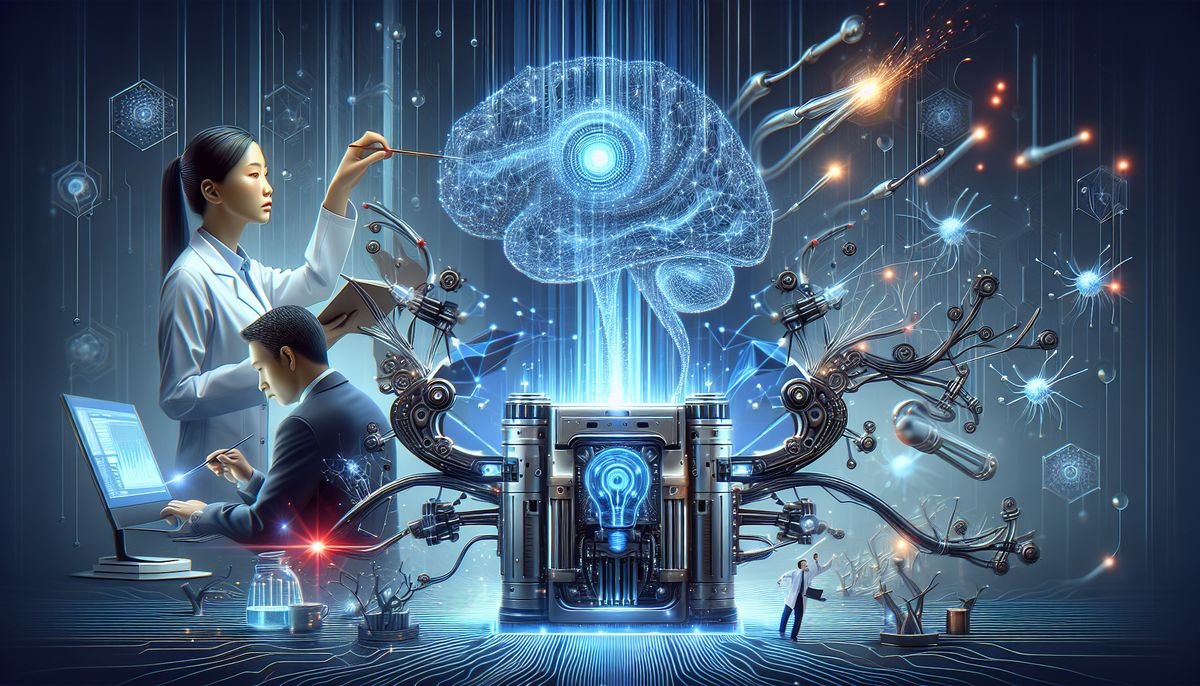The advent of generative AI models has opened up a new frontier in business innovation, offering companies unprecedented opportunities to enhance their operations, creativity, and strategic planning. This article delves into the latest trends in generative AI and how they are being leveraged for business growth, providing a roadmap for integrating these powerful tools into corporate strategies for competitive advantage.
Key Takeaways
- Generative AI models are transforming business operations by automating creative tasks, streamlining workflows, and fostering industry-specific innovations.
- Incorporating generative AI into corporate strategies requires careful evaluation of use cases, leveraging analytic and reporting tools, and a structured approach to implementation.
- The impact of generative AI on business is not hypothetical; it’s a current reality with tangible benefits, as evidenced by its growing adoption across industries.
Revolutionizing Business Operations with Generative AI
Automating Content Creation and Design
The advent of generative AI has brought about a seismic shift in how businesses approach content creation and design. Generative AI tools are now essential for companies looking to stay ahead in the digital landscape. They enable the rapid production of personalized content, which is key to engaging modern consumers. For instance, AI-driven marketing campaigns can produce personalized content, tailoring messages to specific demographics, from product recommendations to personalized emails.
In the realm of content creation, a variety of tools have emerged as frontrunners. Here’s a snapshot of the top generative AI tools that are redefining content creation:
- Synthesia for video content generation
- Bardeen for automating repetitive tasks
- Generated.photos for creating realistic images
- Rephrase.ai for video dubbing and voiceovers
- Descript for audio editing and podcast production
- Murf.ai for voice synthesis
These tools not only enhance creativity but also ensure consistency and quality across various content formats. Moreover, they significantly cut down the time and resources required to produce content at scale.
The integration of generative AI into content creation workflows is not just about efficiency; it’s about unlocking new possibilities and driving innovation.
As businesses continue to leverage these tools, we witness a transformation in industries where the ability to quickly generate high-quality content is becoming a competitive advantage. The impact of generative AI on business operations is profound, offering a glimpse into a future where human creativity is augmented by the power of AI.
Streamlining Workflows for Enhanced Productivity
In the dynamic landscape of business technology, Generative AI is becoming a cornerstone for enhancing productivity. By automating routine tasks, these AI models are transforming the way companies approach their workflows. For instance, Generative AI models can streamline processes by researching industries, personas, companies, and qualification questions, which is particularly beneficial in sales and marketing departments.
The integration of Generative AI into corporate workflows is not just about automation; it’s about redefining the allocation of human resources to more strategic tasks.
When implemented strategically, generative AI can free up resources and streamline tedious and often time-consuming processes. This shift allows employees to focus on higher-value work, fostering an environment of innovation and strategic thinking. The recent trend of using Generative AI for continuous testing and evaluation of large language model-based applications is a testament to its growing influence in business operations.
- Automating Routine Tasks: Reducing manual effort in data entry and analysis.
- Enhancing Decision Making: Providing insights for better business outcomes.
- Continuous Improvement: Enabling iterative testing and refinement of AI models.
- Strategic Resource Allocation: Redirecting human capital to more impactful areas.
Transforming Industries with AI-Driven Innovation
The landscape of business innovation is being reshaped by the advent of Generative AI, which is not merely a fleeting trend but a cornerstone of modern enterprise. This technology is automating essential tasks across various sectors, from content creation to image generation, and even coding, thereby streamlining workflows and driving efficiency.
In particular, the fashion industry has witnessed a surge in AI’s role in producing distinctive designs, showcasing the technology’s ability to foster creativity and accelerate the design process for innovative products. The potential of Generative AI to reduce time, effort, and costs is a compelling reason for its growing adoption.
Generative AI services are sparking creativity and fueling exploration, enabling businesses to maintain a competitive edge. This is crucial in an era where AI digital transformation is pivotal for business innovation.
Moreover, Generative AI is addressing workforce shortages by supporting existing teams, allowing them to keep pace with rapid changes. Advanced AI and ML technologies, such as multimodal models and text embeddings, are simplifying time-consuming data processes, redistributing responsibilities, and reimagining workflows, thus catalyzing a new wave of business innovation.
Integrating Generative AI into Corporate Strategy
Evaluating Use Cases for Competitive Advantage
In the rapidly evolving landscape of generative AI, businesses are keen to identify use cases that can provide them with a competitive edge. Over the past few months, the trend has been to leverage generative AI for enhancing customer experiences and streamlining operations. For instance, the hospitality industry has seen a surge in using AI for personalized guest services, while finance sectors are employing AI for risk assessment and fraud detection.
- Automated & Personalized Customer Support: AI-driven chatbots and virtual assistants are now capable of providing personalized support to customers, learning from interactions to improve service quality.
- Risk Assessment and Fraud Detection: Financial institutions are utilizing generative AI to analyze patterns and predict fraudulent activities, significantly reducing the risk of financial losses.
Embracing generative AI not only streamlines workflows but also opens up new avenues for innovation and service enhancement.
The key to successful integration lies in the careful evaluation of potential applications and their alignment with business goals. Companies must consider the technical expertise required and the associated costs to ensure that the investment in generative AI translates into tangible benefits.
Leveraging Analytic and Reporting Tools
In the dynamic landscape of business technology, analytic and reporting tools have become indispensable for companies aiming to stay ahead of the curve. These tools are not just about understanding data; they’re about transforming it into actionable insights that can drive strategic decisions and foster innovation.
One of the most significant trends in the past three months has been the integration of generative AI into analytic platforms. This has enabled businesses to not only analyze large amounts of data but also to automate routine tasks and content creation, leading to a more efficient use of resources.
The generative AI wave is redefining how we approach problem-solving and decision-making in business, offering a blend of predictive analytics and creative capabilities.
Here’s how businesses are currently leveraging these tools:
- Identify Emerging Trends and Behaviors: By analyzing customer data, companies can spot new market opportunities and adjust their strategies accordingly.
- Upgrade Company Software: Incorporating AI into existing systems enhances their functionality, making them more adaptable to changing business needs.
- Automate Routine Tasks: From report generation to data entry, AI can take over repetitive tasks, freeing up human talent for more complex challenges.
The key to successfully integrating these tools lies in understanding their potential and aligning them with the company’s strategic goals. As we continue to witness the evolution of generative AI, it’s clear that its role in analytics and reporting will only grow more significant.
Navigating the Journey from Concept to Implementation
The transition from conceptualizing generative AI to integrating it into business operations is a critical phase. Businesses must be strategic in their approach, ensuring that the AI solutions align with their goals and provide tangible benefits. A recent trend in this domain is the focus on product-led growth (PLG), where generative AI is leveraged to enhance product development and user experience.
The journey from concept to implementation involves multiple stages, each requiring careful consideration and execution.
Here are some key steps to consider:
- Vision: Establish a clear vision for how generative AI will be used within the organization.
- Strategy: Develop a comprehensive strategy that includes milestones, KPIs, and expected outcomes.
- Product Goals: Set specific goals for product enhancement using generative AI.
- Feedback and Iteration: Implement a feedback loop to continuously improve the AI models based on user interaction.
It’s essential to view generative AI as a complementary tool that can drive innovation and efficiency. As highlighted by Forbes, a thoughtful approach is crucial for successful implementation. Additionally, ITRex suggests that generative AI can automate customer service and support tasks, further personalizing the client experience beyond content creation.
Embracing the Future: The Indelible Mark of Generative AI on Business Innovation
As we have explored throughout this article, the advent of generative AI models marks a significant milestone in the realm of business innovation. These cutting-edge technologies are not merely a fleeting trend but a cornerstone for future growth and efficiency. By automating tasks such as content creation, image generation, and even coding, generative AI empowers businesses to streamline operations and foster creativity, leading to a competitive edge in a rapidly evolving market. The potential of generative AI to reshape industries is evident, with its applications already making profound impacts across various sectors. As businesses continue to adopt and integrate these powerful tools into their strategies, we stand on the cusp of a new era where the synergy between human ingenuity and artificial intelligence will unlock unprecedented possibilities for growth, efficiency, and innovation.
Frequently Asked Questions
What are the latest trends in Generative AI for business innovation?
One of the newest trends in Generative AI for business innovation is the application of AI-powered services to generate creative content such as text, images, music, and 3D models. This trend is revolutionizing industries by automating content creation, streamlining workflows, and driving efficiency, ultimately leading to reduced time, effort, and costs in business operations.
How can Generative AI transform my business operations?
Generative AI can transform your business operations by automating routine tasks such as content creation, image generation, and coding. It streamlines workflows, enhances productivity, and fosters innovation, allowing your business to maintain a competitive edge. By leveraging Generative AI, you can significantly reduce operational costs and free up resources for strategic initiatives.
What are the steps to integrate Generative AI into my corporate strategy?
To integrate Generative AI into your corporate strategy, start by evaluating potential use cases that offer a competitive advantage. Leverage analytic and reporting tools to measure the impact and refine your approach. Finally, navigate the journey from concept to implementation by experimenting, testing, adopting, and scaling Generative AI technologies in line with your business objectives.



